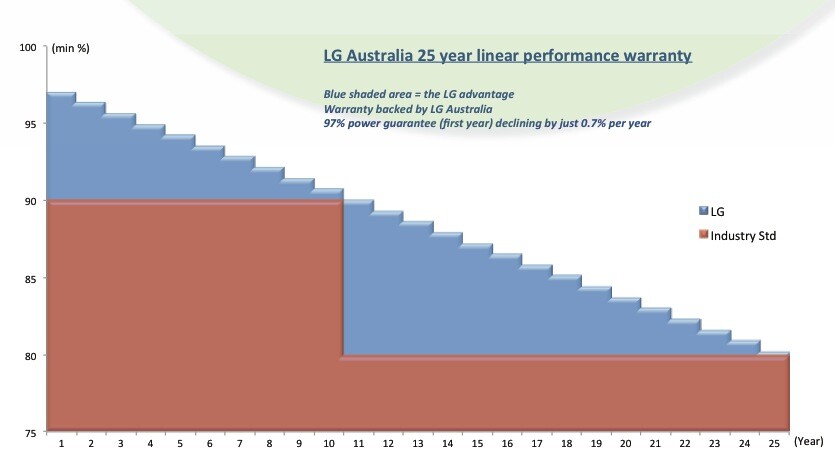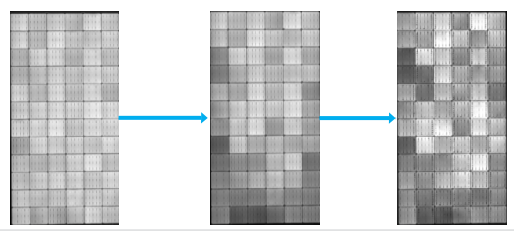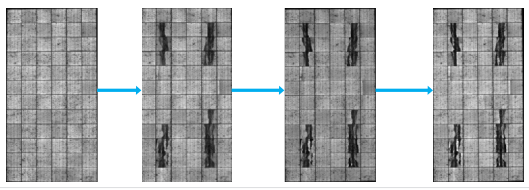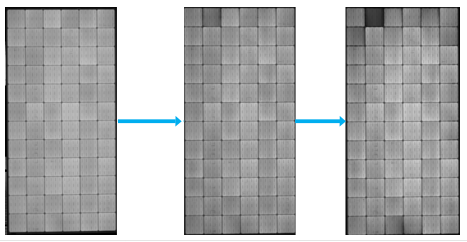DNV GL have published the 2018 results of their solar panel reliability testing for this year, with the 2018 PV Module Reliability Scorecard published in late May this year. The company’s annual report is fast becoming a complementary (or alternative) measure of solar panel quality to commonly used ‘tier ranking‘ systems (mainly the one created by BNEF).
So which panels performed the best in the 2018 report? We’ve summarised (and explained) the results below.
Who are DNV GL?
Suffice to say that DNV GL is a large (over 13k employees and 350 offices globally), old (with history as far back as 1864) organisation involved in a wide range of industries and activities – including renewable energy generation research & testing. You can find more about them on Wikipedia if you have time. All in all, they are a solid outfit with a great reputation and lots of experience.
DNV GL’s PV solar module reliability testing
One of the things that DNV GL does is solar panel reliability testing. They do the testing with end users in mind, and the results are immediately relevant to anyone considering buying solar panels and wanting to pick out a solid, reliable product.
Solar panels are sold in Australia (and many other places) with a performance warranty of 25 years, over which period their power output capacity can be expected to degrade very gradually (less than 1% annually) due various stressors in their operational environment.
Example solar panel performance warranty structure covering degradation over 25 years (from LG Solar).
Compare Solar & Battery Quotes
Since most products and technologies have not been around that long, we’re left with a crucial question: “How do you know the panels will actually perform as expected over 25 years?” DNV GL endeavours to answer this question by essentially beating the hell out of them through a serious of tests that accelerate the ‘natural’ ageing process; these tests go above and beyond the minimum required for products to get the certifications they need to be sold legally (e.g. IEC and UL).
Additionally, they ensure that the modules they are testing are not ‘golden panels’ handed up directly by the manufacturer specifically for testing purposes, but rather ones randomly selected from the factory by DNV GL themselves or by their agents.
In a nutshell, DNV GL:
- Procures randomly selected modules from a range of manufacturers, ensuring that they also know which manufacturing plans (and countries) they come from as well as what materials are used. (The module manufacturers chosen for the Scorecard testing are drawn from those who participate in DNV GL’s Product Qualification Program (PQP), which has more of a focus on the quality of the components used in panels as opposed to whole modules. This is why the list of participants changes from year to year, although many companies have been submitting panels all along.)
- Subjects them to five types of stress which panels may encounter in real-life operation – but much, much harsher. There are actually four test sequences that DNV GL use which incorporate all of these things in different measures to emulate a ‘real life context’. These five stressors are:
- ‘Thermal cycling’ – simulating extreme temperatures
- ‘Damp heat’ – simulating high humidity in warm conditions (especially relevant for hot, humid climates)
- ‘Dynamic Mechanical load’ – simulating physical force on the modules (e.g. from handling/transportation, wind loads, etc)
- ‘Humidity freeze’ – simulating cold & wet conditions (especially relevant for cold, damp climates)
- ‘Potential Induced Degradation’ (PID) – a bit technical, but has to do with static electricity in the module frames, which damages their power generation capacity
- Complies performance rankings for each test, listing the top performers by name (and product number) but anonymising the data for the under-performers; also included are notes about whether the same products were named as a top performer in previous years.
- Publishes the results for the world to see. For manufacturers who (pay to) participate in the PQP, appearing in the scorecard is part of the package – free exposure and potential marketing material, without the fear of being ‘named and shamed’ if their products don’t make it into the ranks of the ‘top performers’.
What are the test sequences?
Thermal cycling
As solar panels heat up and cool down, they expand and contract, which can affect the way that the components inside are held together. The thermal cycling test sees the panels sit in temperatures of -40°C to 85°C 600x times. This is well beyond anything panels are likely to face in the real world, but the whole point is to create an environment of accelerated stressing – so if they do well here, they’re likely to also perform well in real life.
 Damp heat
Damp heat
Hot, humid conditions can be bad for panels not constructed to withstand them, resulting in the various layers of materials (glass, silicon cells, etc) to become ‘unglued’ from one another. DNV GL subject the panels to about 42 days’ worth of 85% humidity at 85°C. According to the report: “While high temperature/high humidity occur regularly in many parts of the world, the damp heat testing sequence is effective at uncovering degradation and failure modes associated with long term exposure even in moderate climates.”
Mechanical load / Thermal cycling / Humidity freeze
This test cycle combines a three different types of stressors, emulating conditions where heavy winter snows are common but also more generally uncovering potential issues with a panel’s construction.
According to the report:
For the DML test sequence, the module is installed according to the manufacturer’s recommended mounting configuration and is subjected to 1,000 cycles of alternating loading at 1,000 Pa. During the test, DNV GL monitors continuity of the module’s electrical circuit and leakage current to the module frame. After an interim characterization, the module is stressed in chamber for 50 thermal cycles to cause microcrack propagation before undergoing 10 humidity freeze cycles to fully realize the potential power loss. The 2018 PQP extends the humidity freeze cycles from one set of 10 cycles to three sets of 10 cycles.
Potential induced degradation (PID)
Potential induced degradation (PID) is a technical issue with solar panels that probably makes the least intuitive sense and seem the most abstract to people in the market for a solar PV system. Basically, it has to do with electrical grounding configurations and does not apply to all panels or all all solar system setups.
From the report:
During the test, a voltage bias equal to the system voltage rating of the module (either -1 kV or -1.5 kV) is applied under 85°C and 85% relative humidity conditions for two sessions of 96 hours. This accelerated environment provides the temperature, moisture and voltage bias conditions necessary to evaluate degradation related to increased leakage current.
It should be noted that there are reversible and non-reversible PID mechanisms. Electrochemical corrosion and some sodium ion damage to the PN junction are widely considered irreversible, while PID due to the accumulation of static charge on the surface of cells, also known as polarization, can be reversed.
Results from the 2018 Reliability Scorecard
It’s important to note that this is an incomplete list – not every solar panel available in the world is tested by DNV GL. This goes for both high-end manufacturers as well as a number who would be classified as ‘tier 3’. That being said, the company says that about 70% of the world’s largest manufacturers are represented in the results.
Some other things to keep in mind as you peruse the results:
- While we’ve listed the results below by manufacturer brand, in fact DNV GL tests them by the product model – and some manufacturers have several product models represented in the results. To work out which products performed well on each test, you can have a look at the scorecard report itself. The last column includes very generalised info on the types of modules tested (see report for exact module models, etc). As a general rule, 60 cell modules are for residential applications, while 72 cell modules are more common in commercial applications.
- Not all of the modules tested are available in Australia. We’ve cross-checked the ones included in DNV GL’s Scorecard report against those listed on the CEC’s list of approved modules to work out which are approved to be used here (although whether, where through which companies they’re available is another question…)
- Keep in mind that there are other quality/reliability schemes in place for some modules not covered by DNV GL. Australia’s own Choice Magazine, for example, conducts their own independent tests and publishes the results (but you have to be a paying Choice member to see them). Additionally, the Australian Solar Council has a ‘Positive Quality‘ program that does factory inspections & independent module testing (note that manufacturers must opt in and pay to participate in this scheme, which helps their marketability – currently, only two companies participate).
| Factory location | Thermal cycling | Damp heat | Dynamic mechanical load / Humidity-freeze | Potential Induced Degradation | Notes about modules used | |
| BYD | Shanghai, China | X | X | X | X | 72 cell |
| First Solar | Perrysburg, Ohio USA | X | X | Commercial modules only | ||
| GCL | Song Khe-Noi Hoang Industrial Zone, Vietnam | X | X | X | X | 72 cell |
| Hanwha QCells | Cyberjaya, Malaysia, Eumseong Gun, South Korea | X | X | X | 60 cell | |
| HT-SAAE | Istanbul, Turkey | X | X | X | X | 72 for all, 60 cell for damp heat & PID |
| JA Solar | Shanghai, China; Ningjin, China; Van Trung Industrial Park, Vietnam | X | X | X | 60 cell for thermal cycling & PID, 60 & 72 cell for damp heat & mech load | |
| Jinko Solar | ShangRao, China | X | X | X | X | 60 & 72 cell |
| LG Electronics | Gumi, South Korea | X | X | X | 72 cell | |
| LONGi Solar | Taizhou, China | X | X | X | X | 60 & 72 cell |
| Phono Solar | Nanjing, China | X | 72 cell | |||
| REC Solar | Tuas, Singapore | X | X | X | X | 72 cell size equivalent |
| SunPower | Mexicali, Mexico | X | X | X | X | 72 cell size equivalent |
| Suntech Power | Wuxi, China | X | X | X | X | 60 cell |
| Trina Solar | Changzhou, China; Pluakdaeng, Thailand | X | X | X | X | 60 & 72 cell |
| Yingli Solar | Baoding, China | X | X | X | X | 72 cell |
| Other high-performing manufacturers not accredited for Australia | ||||||
| Adani | Gujarat, India | X | X | X | X | |
| Astroenergy | Haining, China | X | X | X | ||
| Flex | Geland Patah, Malaysia | X | X | X | X | |
| Neo Solar | Van Trung Industrial Park, Vietnam | X | X | X | ||
| Panasonic | Kulim, Malaysia | X | X | X | ||
| Solaria | Freemont, California USA | X | ||||
| Sunspark | Riverside, California USA | X | X | X | ||
DNV GL Reliability Scorecard top performers: 2014 to present
Each year the modules and brands tested for DNV GL’s Scorecard can change – new ones enter, old ones leave the testing regime and still others may not have their names mentioned due to failure to achieve ‘Top Performer’ status.
That being said, the ones who have made the ranks for the four years straight that DNV GL have been publishing the Scorecard results have something worthy of bragging about – arguably more noteworthy than achieving BNEF ‘Tier 1’ manufacturer status. To date, these are Jinko Solar, Trina Solar and Yingli Solar.
All in all, the DNV GL results are a good reference point for solar panel quality, to be considered in conjunction with other systems like BNEF’s tier rankings as well as factors such as the company’s service presence in the country of purchase (Australia, in our case).
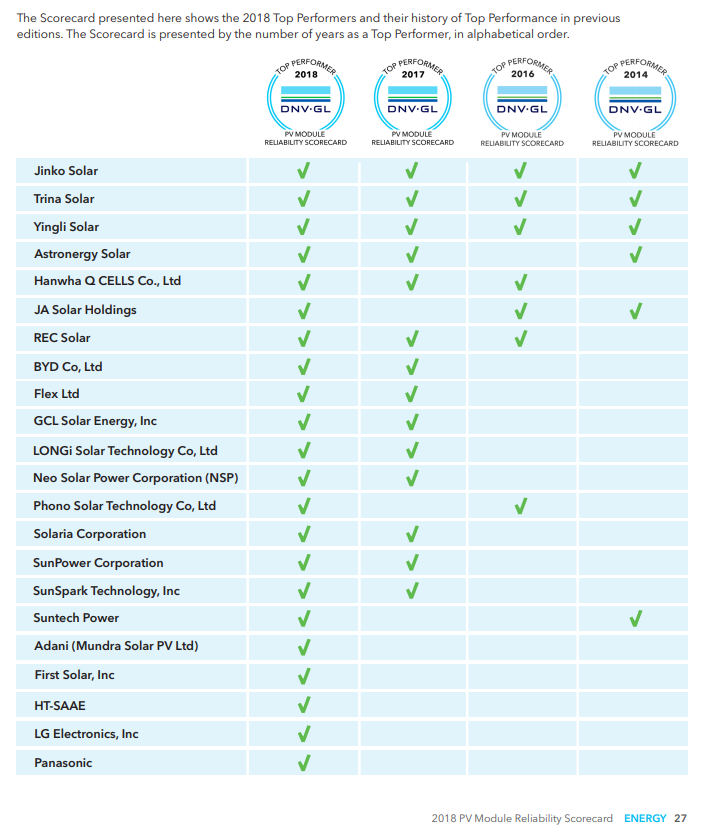 Compare Solar & Battery Quotes
Compare Solar & Battery Quotes
- Why a big battery could be cheaper than a small battery with the federal rebate? - 19 June, 2025
- Heat Pump Costs – Solar Choice Price Index - 1 June, 2025
- Solar Panel Costs: Solar Choice Price Index | July 2025 - 1 June, 2025
